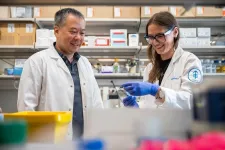(Press-News.org) Background: We previously demonstrated the successful use of in vivo CRISPR gene editing to delete 4-hydroxyphenylpyruvate dioxygenase (HPD) to rescue mice deficient in fumarylacetoacetate hydrolase (FAH), a disorder known as hereditary tyrosinemia type 1 (HT1). The aim of this study was to develop an ex vivo gene-editing protocol and apply it as a cell therapy for HT1.
Methods: We isolated hepatocytes from wild-type (C57BL/6J) and Fah-/- mice and then used an optimized electroporation protocol to deliver Hpd-targeting CRISPR-Cas9 ribonucleoproteins into hepatocytes. Next, hepatocytes were transiently incubated in cytokine recovery media formulated to block apoptosis, followed by splenic injection into recipient Fah-/- mice.
Results: We observed robust engraftment and expansion of transplanted gene-edited hepatocytes from wild-type donors in the livers of recipient mice when transient incubation with our cytokine recovery media was used after electroporation and negligible engraftment without the media (mean: 46.8% and 0.83%, respectively; p=0.0025). Thus, the cytokine recovery medium was critical to our electroporation protocol. When hepatocytes from Fah-/- mice were used as donors for transplantation, we observed 35% and 28% engraftment for Hpd-Cas9 ribonucleoproteins and Cas9 mRNA, respectively. Tyrosine, phenylalanine, and biochemical markers of liver injury normalized in both Hpd-targeting Cas9 ribonucleoprotein and mRNA groups independent of induced inhibition of Hpd through nitisinone, indicating correction of disease indicators in Fah-/- mice.
Conclusions: The successful liver cell therapy for HT1 validates our protocol and, despite the known growth advantage of HT1, showcases ex vivo gene editing using electroporation in combination with liver cell therapy to cure a disease model. These advancements underscore the potential impacts of electroporation combined with transplantation as a cell therapy.
END
Ex vivo gene editing and cell therapy for hereditary tyrosinemia type 1
2024-06-14
ELSE PRESS RELEASES FROM THIS DATE:
Intranasal COVID-19 vaccine headed to clinical trials
2024-06-14
University of Georgia-based startup CyanVac LLC received federal funding to support a comparative Phase 2b clinical trial of CVXGA, the company’s intranasal vaccine candidates designed to protect against COVID-19.
As part of the award from Project NextGen, a federal initiative based in the U.S. Department of Health and Human Services (HHS), CyanVac will sponsor a randomized, double-blind Phase 2b study with 10,000 participants to compare the efficacy and safety of the intranasal vaccine against an FDA-approved mRNA-based COVID-19 vaccine.
The new vaccine is based on a viral delivery platform developed by He containing modified ...
High out-of-pocket costs may be barrier to filling naloxone prescriptions, study shows
2024-06-14
Patients are less likely to fill prescriptions for naloxone when they face increases in out-of-pocket costs, according to U-M researchers.
Patients are less likely to fill prescriptions for naloxone when they face increases in out-of-pocket costs, according to research by the University of Michigan.
Published in the Journal of the American Medical Association, the study utilized data from a national pharmacy transactions database from November 2020 to March 2021. Researchers found that about 1 in 3 naloxone ...
Sharks have depleted functional diversity compared to the last 66 million years
2024-06-14
New research by Swansea University and the University of Zurich has found that sharks retained high levels of functional diversity for most of the last 66 million years, before steadily declining over the last 10 million years to its lowest value in the present day.
Modern sharks are among the ocean’s most threatened species; yet have notably survived numerous environmental changes in their 250-million-year history. Today, their more than 500 species play many different ecological roles, from apex predators to nutrient transporters.
Ecological roles are determined by species’ traits such as body size, ...
Fasting primes the immune system’s natural killer cells to better fight cancer, new study in mice finds
2024-06-14
Periods of fasting reprogram the immune system’s natural killer cells to better fight cancer, according to a new study in mice from researchers at Memorial Sloan Kettering Cancer Center (MSK).
Fasting and other dietary regimens are increasingly being explored as ways to starve cancer cells of the nutrients they need to grow and to make cancer treatments more effective.
Now a team of researchers from MSK’s Sloan Kettering Institute and their collaborators have shown for the ...
Are patient partners a necessity in research?
2024-06-14
Sjögren’s disease is a systemic autoimmune disorder that often causes sicca symptoms – or dryness of the eyes and mouth, alongside many other complications such as fatigue, pain, and neurological manifestations. There are treatments that help with symptoms, but none that address the underlying disease processes.3 One key issue in developing new treatments is that Sjögren’s can differ from person to person – and that makes it hard to measure and compare outcomes in a clinical trial.
NECESSITY is an interventional trial looking at new clinical endpoints in Sjögren’s disease. ...
Encouraging cooperation in inflammatory arthritis
2024-06-14
Inflammatory arthritis describes a group of diseases caused by an overactive immune system. The different types of inflammatory arthritis include rheumatoid arthritis, psoriatic arthritis, juvenile idiopathic arthritis, and ankylosing spondylitis. The most common symptoms are joint pain and stiffness. Pain is the predominant symptom in the majority of people with inflammatory arthritis, which contributes to the global burden of rheumatic and musculoskeletal conditions.1 Knowledgeable support can reduce ...
Protection against disease and treatment toxicity
2024-06-14
Autologous hematopoietic stem cell transplantation (aHSCT) for SSc has been proven the most effective treatment strategy with regard to overall and event free survival in selected patients.2 But a key limitation is its toxicity, and new treatment options are needed. Two abstracts presented at the 2024 EULAR congress in Vienna focused on novel approaches.
Jörg Henes presented on behalf of the AST MOMA investigators. This prospective, open-label, study evaluated the feasibility of aHSCT in patients with impaired lung or heart function, and also ...
Does BMO induced by mechanical stress progress to structural lesions?
2024-06-14
BMO in the sacroiliac joint on MRI is present in up to 84% of people with non-radiographic axSpA – but it is also often seen in a non-inflammatory setting, such as in women after childbirth.1,2 As back pain is common after childbirth, differential diagnosis with axSpA is an important issue in clinical practice.1 In axSpA, active inflammatory lesions are likely to progress to structural lesions over time – particularly fat lesions and erosions. But it is not known whether the same is true for BMO induced by mechanical stress. In June 2024, EULAR – The European Alliance of Associations for Rheumatology – held its annual congress ...
Is fish intake linked to JIA?
2024-06-14
In 2019, a Swedish prospective birth cohort study of over 15,000 children showed that consuming fish at least once a week during pregnancy and during the first year of life was associated with up to a 5-fold increased risk of JIA, compared to those with fish consumption less than once a week. This increased risk was primarily attributed to elevated exposure to heavy metals.1 Now, new research shared at the 2024 congress of EULAR – The European Alliance of Associations for Rheumatology – is investigating ...
Unpicking the complexity of systemic sclerosis
2024-06-14
SSc is a connective tissue disease with variable clinical presentation. It may affect the skin, blood vessels, heart, lungs, kidneys, gastrointestinal tract, and musculoskeletal system – and this complexity and diversity makes it challenging to treat.2 This clinical heterogeneity in SSc may be partially explained by SSc-specific antibodies, but a better understanding of additional risk factors and patient stratification is still needed. Three abstracts shared at the 2024 EULAR congress present a selection of new clinical research to enrich knowledge ...

